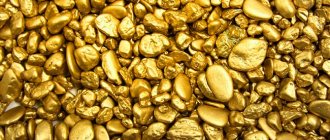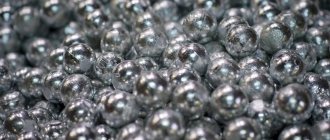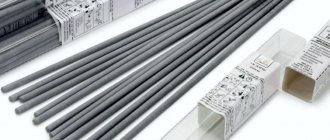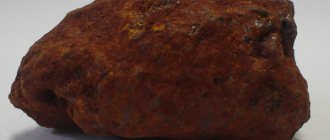Metals are the most common material (along with plastics and glass) that has been used by people since ancient times. Even then, man knew the characteristics of metals; he profitably used all their properties to create beautiful works of art, dishes, household items, and structures.
By the way, I recommend buying an accurate analyzer of metals and alloys from the Olympas-NK.RF company at the best prices.
One of the main features when considering these substances is their hardness and refractoriness. It is these qualities that make it possible to determine the area of use of a particular metal. Therefore, we will consider all the physical properties and pay special attention to the issues of fusibility.
Physical properties of metals
The characteristics of metals by physical properties can be expressed in the form of four main points.
- Metallic luster - all have approximately the same silvery-white beautiful characteristic luster, except for copper and gold. They have a reddish and yellow tint, respectively. Calcium is silvery blue.
- Physical state - all solids under ordinary conditions, except mercury, which is in the form of a liquid.
- Electrical and thermal conductivity is characteristic of all metals, but is expressed to varying degrees.
- Malleability and ductility are also parameters common to all metals, which can vary depending on the specific representative.
- Melting and boiling points determine which metal is refractory and which is fusible. This parameter is different for all elements.
All physical properties are explained by the special structure of the metal crystal lattice. Its spatial arrangement, shape and strength.
Alloys
To change the properties of a particular metal, it is alloyed with other substances. Thus, it can not only acquire greater density and strength, but also reduce or increase the melting point.
An alloy can consist of two or more chemical elements, but at least one of them must be a metal. Such “mixtures” are very often used in industry, because they make it possible to obtain exactly the qualities of materials that are needed.
The melting point of metals and alloys depends on the purity of the former, as well as on the proportions and composition of the latter. To obtain low-melting alloys, lead, mercury, thallium, tin, cadmium, and indium are most often used. Those containing mercury are called amalgams. A compound of sodium, potassium and cesium in a ratio of 12%/47%/41% becomes a liquid already at minus 78 ° C, an amalgam of mercury and thallium - at minus 61 ° C. The most refractory material is an alloy of tantalum and hafnium carbides in 1:1 proportions with a melting point of 4115 °C.
Low-melting and refractory metals
This parameter is very important when it comes to the areas of application of the substances in question. Refractory metals and alloys are the basis of machine and shipbuilding, smelting and casting of many important products, and obtaining high-quality working tools. Therefore, knowledge of melting and boiling points plays a fundamental role.
Characterizing metals by strength, we can divide them into hard and brittle. If we talk about refractoriness, then there are two main groups:
- Low-fusibility ones are those that are capable of changing their state of aggregation at temperatures below 1000 °C. Examples include: tin, lead, mercury, sodium, cesium, manganese, zinc, aluminum and others.
- Refractory are those whose melting point is higher than the indicated value. There are not many of them, and even fewer are used in practice.
A table of metals with a melting point above 1000 °C is presented below. This is where the most refractory representatives are located.
| Metal name | Melting point, oC | Boiling point, oC |
| Gold, Au | 1064.18 | 2856 |
| Beryllium, Be | 1287 | 2471 |
| Cobalt, Co | 1495 | 2927 |
| Chromium, Cr | 1907 | 2671 |
| Copper, Cu | 1084,62 | 2562 |
| Iron, Fe | 1538 | 2861 |
| Hafnium, Hf | 2233 | 4603 |
| Iridium, Ir | 2446 | 4428 |
| Manganese, Mn | 1246 | 2061 |
| Molybdenum, Mo | 2623 | 4639 |
| Niobium, Nb | 2477 | 4744 |
| Nickel, Ni | 1455 | 2913 |
| Palladium, Pd | 1554,9 | 2963 |
| Platinum, Pt | 1768.4 | 3825 |
| Rhenium, Re | 3186 | 5596 |
| Rhodium, Rh | 1964 | 3695 |
| Ruthenium, Ru | 2334 | 4150 |
| Tantalus, Ta | 3017 | 5458 |
| Technetium, Ts | 2157 | 4265 |
| Thorium, Th | 1750 | 4788 |
| Titanium, Ti | 1668 | 3287 |
| Vanadium, V | 1910 | 3407 |
| Tungsten, W | 3422 | 5555 |
| Zirconium, Zr | 1855 | 4409 |
This table of metals includes all representatives whose melting point is above 1000 °C. However, in practice, many of them are not used for various reasons. For example, due to economic benefits or due to radioactivity, too high a degree of fragility, susceptibility to corrosive effects.
It is also obvious from the table data that the most refractory metal in the world is tungsten. Gold has the lowest rate. When working with metals, softness is important. Therefore, many of the above are also not used for technical purposes.
Obtaining refractory materials
The main difficulty encountered in the production of refractory metals and alloys is their high chemical activity, which prevents the element from being present in its pure form.
Installation for producing refractory metals
The most common production technology is powder metallurgy. There are several ways to obtain refractory metal powder.
- Reduction with hydrogen trioxide. This method includes several stages; the processing equipment is multi-tube furnaces, with a temperature range from 750 to 950 ° C. This method is used to produce molybdenum and tungsten.
- Reduction with hydrogen from ammonium perrhenate. At a temperature of about 500 °C, at the final stage, the resulting powder is separated from alkalis using acids and water. Used to produce rhenium.
- Salts of various metals are also used to obtain molybdenum powder. For example, use ammonium salt of the metal and its powder, no more than 15% of the total mass. The mixture is heated to 500-850 °C using inert gas, and then the production technology provides for reduction with hydrogen at a temperature of 850-1000 °C.
Production of refractory metals
The powder obtained by these methods is subsequently sintered into special forms for further transportation and storage.
Today, these methods for obtaining pure refractory metals continue to be refined and new techniques for extracting material from rocks are being applied. With the development of nuclear energy, the space industry, and metallurgy, we will soon be able to observe the emergence of new methods, perhaps cheaper and simpler.
The most refractory metal is tungsten
In the periodic table it is located at serial number 74. It was named after the famous physicist Stephen Wolfram. Under normal conditions, it is a hard, refractory metal with a silvery-white color. Has a pronounced metallic luster. Chemically practically inert, it reacts reluctantly.
Found in nature in the form of minerals:
- wolframite;
- scheelitis;
- hübnerite;
- ferberite
Scientists have proven that tungsten is the most refractory metal of all existing ones. However, there are suggestions that seaborgium is theoretically capable of breaking the record of this metal. But it is a radioactive element with a very short lifetime. Therefore, it is not yet possible to prove this.
At a certain temperature (over 1500 °C), tungsten becomes malleable and ductile. Therefore, it is possible to produce thin wire based on it. This property is used to make filaments in ordinary household light bulbs.
As the most refractory metal, withstanding temperatures above 3400 °C, tungsten is used in the following areas of technology:
- as an electrode for argon welding;
- for producing acid-resistant, wear-resistant and heat-resistant alloys;
- as a heating element;
- in vacuum tubes as filament and so on.
In addition to metal tungsten, its compounds are widely used in technology, science and electronics. As the most refractory metal in the world, it forms compounds with very high-quality characteristics: strong, resistant to almost all types of chemical influences, non-corrosive, and can withstand low and high temperatures (tungsten sulfide, its single crystals and other substances will win).
Receiving technology
The source of most refractory materials is ore.
The process is traditional:
- Impurities are removed from it.
- Refined (restores the desired element). The recovery method depends on the required degree of metal purity. Therefore, arc-shaped, electron beam or plasma melting is used.
- Plasma produces the best product. It comes in the form of small granules, powder or blanks (wire, foil, ingots, fittings, rolled products).
The melting technology is specific, so special enterprises deal with such raw materials. There were only two of them in the USSR.
Processing of refractory metals is possible only by powder metallurgy methods.
Niobium and its alloys
Nb, or niobium, is a silvery-white shiny metal under normal conditions. It is also refractory, since the temperature of transition to the liquid state for it is 2477 °C. It is this quality, as well as the combination of low chemical activity and superconductivity, that allows niobium to become increasingly popular in human practice every year. Today this metal is used in industries such as:
- rocket science;
- aviation and space industry;
- nuclear power;
- chemical apparatus engineering;
- radio engineering.
This metal retains its physical properties even at very low temperatures. Products based on it are characterized by corrosion resistance, heat resistance, strength, and excellent conductivity.
This metal is added to aluminum materials to improve chemical resistance. Cathodes and anodes are made from it, and non-ferrous alloys are alloyed with it. Even coins in some countries are made with niobium content.
Physical and mechanical properties
Refractory metals are included in the group of transition elements. The periodic table distinguishes two types of them:
- niobium, tantalum, vanadium are included in subgroup 5A;
- chromium, tungsten and molybdenum - in subgroup 6A.
Vanadium has the lowest density (6100 kg/m3), and tungsten has the maximum density (19300 kg/m3). The remaining metals are within this range in terms of specific density. All of them have a low coefficient of linear expansion, low thermal conductivity and elasticity. The elements conduct electricity poorly, but are superconductive. Depending on the type of element, the superconductivity temperature ranges from 0.05 to 9 K.
It is noteworthy that at room temperature, refractory metals are characterized by high ductility. In addition, molybdenum and tungsten are characterized by increased heat resistance compared to other elements. Not all elements have a high degree of heat resistance. Most refractory metals are resistant to the aggressive effects of alkali or acid in normal environments. But when heated to 400 degrees, their activity increases sharply. For this reason, materials require special operating conditions. In high-temperature working environments, they are often placed in a special atmosphere of inert gases or air rarefied to a vacuum.
A common indicator for all elements is a high degree of chemical activity. It is this feature that significantly complicates the production of pure elements, necessitating the construction of a multi-stage technological chain.
In addition, certain difficulties with the use of heat-resistant metals in industrial production are explained by their increased tendency to cold brittleness. In other words, when the temperature of the working environment decreases to a certain point, the material becomes brittle. Vanadium passes this mark at -195 degrees, niobium at -120, and tungsten at +330 degrees Celsius. This feature is explained by the presence of certain impurities in the metal composition.
Tantalum
Metal, in its free form and under normal conditions, covered with an oxide film. It has a set of physical properties that allow it to be widespread and very important for humans. Its main characteristics are as follows:
- At temperatures above 1000 oC it becomes a superconductor.
- It is the most refractory metal after tungsten and rhenium. The melting point is 3017 °C.
- Absorbs gases perfectly.
- It is easy to work with as it can be rolled into sheets, foil and wire without much difficulty.
- It has good hardness and is not brittle, retains ductility.
- Very resistant to chemical agents (does not dissolve even in aqua regia).
Thanks to these characteristics, it has managed to gain popularity as the basis for many heat-resistant and acid-resistant, anti-corrosion alloys. Its numerous compounds are used in nuclear physics, electronics, and computational devices. Used as superconductors. Previously, tantalum was used as an element in incandescent lamps. Now tungsten has taken its place.
Classification
Depending on the melting point, refractory metals are assigned to the main or additional group.
Main group
This segment includes five positions: tungsten, niobium, tantalum, molybdenum, rhenium.
Melts at 2200°C+. Properties of the fourth group of elements
| Name | Niobium | Molybdenum | Tantalum | Tungsten | Rhenium |
| Melting temperature | 2750 K (2477 °C) | 2896 K (2623 °C) | 3290 K (3017 °C) | 3695 K (3422 °C) | 3459 K (3186 °C) |
| Boiling temperature | 5017 K (4744 °C) | 4912 K (4639 °C) | 5731 K (5458 °C) | 5828 K (5555 °C) | 5869 K (5596 °C) |
| Density | 8.57 g cm³ | 10.28 g cm³ | 16.69 g cm³ | 19.25 g cm³ | 21.02 g cm³ |
| Young's modulus | 105 GPa | 329 GPa | 186 GPa | 411 GPa | 463 GPa |
| Vickers hardness | 1320 MPa | 1530 MPa | 873 MPa | 3430 MPa | 2450 MPa |
Molybdenum
The most popular of the refractory elements.
The number one area of use is metallurgy:
- Molybdenum is used to “strengthen” steel to produce a hard alloy.
- Together with stainless steel, it is used as a material for the infrastructure of pipelines, car parts, and other mechanical engineering products.
- Due to its melting point, wear resistance, and low abrasion, it is used as an alloying additive.
Molybdenum requires a couple of percent of alloys in the composition for the properties of the alloy to change.
For example, half a percent titanium plus 0.08% zirconium creates a molybdenum alloy that does not lose strength up to 1060°C.
Extraordinary friction parameters have led to the use of molybdenum as a long-lasting lubricant with high efficiency.
The material is indispensable for mercury relays, since an amalgam with this metal is not formed by mercury.
Tungsten
Opened at the end of the 18th century. The hardest and most refractory (3422°C) metal.
Refractory durable metal, light gray in color - tungsten
Together with copper and iron, it is used as the basis (up to 80%) of alloys with rhenium, thorium, and nickel. Such additives increase density, rust resistance threshold, and reliability.
It is in demand as a material for power supply systems, instruments, ammunition, and nuclear missile warheads. Nickel alloys are valued by golf fans as club materials.
Tungsten ingots
Tungsten and its alloys are in demand where increased density is needed at extreme temperatures.
Tantalum
The most resistant to acids and corrosion from the segment of refractory metals.
Heavy, hard metal of gray color – tantalum
Therefore, it is used in capacitors of smartphones, tablets, and other gadgets.
Compatible with biological organisms (does not change under the influence of natural acids). Because of this, it is used in medicine.
In nature, niobium and tantalum are neighbors. It is no coincidence that they are named after father and daughter – Tantalus and Niobe, characters from ancient Greek myths.
Niobium
Metal with unusual characteristics:
- The lightest (low density) in the segment.
- It is unique due to its ability to change the coefficient of hardness and elasticity depending on the degree of annealing.
- Most common in superconducting alloys.
It is used as a material for capacitors, gas turbines, rockets, and aircraft. As well as an element of nuclear reactors and lamps of electronic devices.
Together with hafnium and titanium, it is a material for spacecraft engines (for example, the American Apollo).
Chrome and its alloys
One of the hardest metals, naturally bluish-white in color. Its melting point is lower than that of the elements considered so far, and is 1907 °C. However, it is still used everywhere in technology and industry, as it lends itself well to mechanical stress, is processed and molded.
Chromium is especially valuable as a coating. It is applied to products to give them a beautiful shine, protect against corrosion and increase wear resistance. The process is called chrome plating.
Chromium alloys are very popular. After all, even a small amount of this metal in the alloy significantly increases the hardness and resistance of the latter to impacts.
Zirconium
It is one of the most expensive metals, so its use for technical purposes is difficult. However, its physical characteristics make it simply indispensable in many other industries.
Under normal conditions it is a beautiful silvery-white metal. It has a fairly high melting point - 1855 oC. It has good hardness and corrosion resistance, as it is not chemically active. It also has excellent biological compatibility with human skin and the entire body as a whole. This makes it a valuable metal for medical use (instruments, prosthetics, etc.).
The main areas of application of zirconium and its compounds, including alloys, are as follows:
- nuclear energy;
- pyrotechnics;
- metal alloying;
- medicine;
- production of bioware;
- construction material;
- like a superconductor.
Even jewelry that can influence the improvement of human health is made from zirconium and alloys based on it.
At what temperature does it melt?
Metal elements, whatever they are, melt almost one to one. This process occurs when heated. It can be both external and internal. The first takes place in a furnace, and for the second, resistive heating is used, passing electricity or induction heating. The impact is almost the same. When heated, the amplitude of molecular vibrations increases. Structural lattice defects are formed, which are accompanied by the breaking of interatomic bonds. The process of lattice destruction and the accumulation of such defects means melting.
Different substances have different melting points. Theoretically, metals are divided into:
- Low-melting - temperatures up to 600 degrees Celsius are sufficient to obtain a liquid substance.
- Medium melting - requires a temperature of 600 to 1600 ⁰C.
- Refractory are metals that require temperatures above 1600 ⁰C to melt.
Melting iron
The melting point of iron is quite high. A technically pure element requires a temperature of +1539 °C. This substance contains an impurity - sulfur, and it can only be extracted in liquid form.
Without impurities, pure material can be obtained by electrolysis of metal salts.
Melting cast iron
Cast iron is the best metal for smelting. The high fluidity rate and low shrinkage rate make it possible to use it more effectively during casting. Next, consider the boiling point of cast iron in degrees Celsius:
- Gray – the temperature can reach 1260 degrees. When pouring into molds, the temperature can rise to 1400.
- White – the temperature reaches 1350 degrees. It is poured into molds at 1450.
Important! The melting rates of a metal such as cast iron are 400 degrees lower compared to steel. This significantly reduces energy costs during processing.
Melting steel
Melting steel at a temperature of 1400 °C
Steel is an alloy of iron mixed with carbon. Its main benefit is strength, since this substance is capable of maintaining its volume and shape for a long time. This is due to the fact that the particles are in an equilibrium position. Thus, the forces of attraction and repulsion between particles are equal.
Reference! Steel melts at 1400 °C.
Melting aluminum and copper
The melting point of aluminum is 660 degrees, which means that it can be melted at home.
Pure copper is 1083 degrees, and for copper alloys it ranges from 930 to 1140 degrees.
Molybdenum
If you find out which metal is the most refractory, then, in addition to the indicated tungsten, you can also name molybdenum. Its melting point is 2623 °C. At the same time, it is quite hard, plastic and amenable to processing.
It is mainly used not in its pure form, but as an integral component of alloys. They, thanks to the presence of molybdenum, are significantly strengthened in wear resistance, heat resistance and anti-corrosion.
Some molybdenum compounds are used as technical lubricants. This metal is also an alloying material that simultaneously affects both strength and corrosion resistance, which is very rare.
What is melting point
Each metal has unique properties, and this list includes its melting point. When melting, the metal changes from one state to another, namely, from solid to liquid. To fuse a metal, you need to bring heat closer to it and heat it to the required temperature - this process is called the melting point. At the moment when the temperature reaches the desired level, it can still remain in a solid state. If you continue the impact, the metal or alloy will begin to melt.
Rhenium and alloys based on it
Which metal is the most refractory after tungsten? This is rhenium. Its fusibility index is 3186 °C. It is superior in strength to both tungsten and molybdenum. Its plasticity is not too high. The demand for rhenium is very high, but production is difficult. As a result, it is the most expensive metal existing today.
Used for making:
- jet engines;
- thermocouples;
- filaments for spectrometers and other devices;
- as a catalyst in oil refining.
All areas of application are expensive, so it is used only in cases of extreme necessity, when there is no possibility of replacing it with anything else.
Types and applications
Due to their unique properties, refractory metals are very useful for various applications and industries. Their main advantages:
- Ultra-high melting point. In particular, refractory metals include tungsten, molybdenum and tantalum, which are used in the production of glass;
- Strength at ultra-high temperatures. For example, rocket cones made of tungsten have twice the tensile strength of iron at normal temperatures;
- Excellent abrasion and wear resistance to extend the life of valve seats, seals, injectors and other high wear areas;
- Excellent corrosion resistance, which is why critical pipelines in chemical plants are usually made of refractory metals;
- Resistance to thermal shock. In particular, tungsten products can withstand stress caused by rapid expansion due to sudden temperature changes;
- Thermal and electrical conductivity, as a result of which radiator parts are made from tungsten and molybdenum;
- Extreme hardness, therefore highly resistant cutting stamping and drilling tools are made from tungsten carbide;
- The high density of refractory metals is the reason for their use in golf club heads and aircraft gyroscopes.
In addition, these materials are used as catalysts for chemical reactions, in nuclear fusion processes, etc.
Refractory metals include the particularly widespread tungsten, molybdenum, niobium, tantalum, rhenium and chromium. The specifics of their use are discussed below.
Tungsten
Tungsten is the most common refractory metal. It has the highest melting point and one of the highest densities. It is also highly resistant to corrosion. Widely used in wire fibers, such as most incandescent lamps used in homes, as well as industrial arc lamps and other lighting equipment.
Molybdenum
Molybdenum is the most used refractory metal of all because it is cheaper than most others and, when made into an alloy, can be very resistant to creep and high temperatures. It also does not form amalgams, making it resistant to corrosion.
Molybdenum is used to strengthen steel alloys, especially in structural piping and tubing. This metal also has excellent anti-friction properties, making it an ideal component in oils and lubricants used in automobiles.
Niobium
It has an optimal combination of ductility and strength. It can be used in the manufacture of electrolytic capacitors, superconductors, nuclear reactors and vacuum tubes.
Tantalum
It is more resistant to corrosion than others, therefore it is used in medicine (especially surgery), as well as in environments with high acidity. Tantalum is also a major component of computer, telephone and capacitor circuits.
Rhenium
Known for its high tensile strength and ductility. It is widely used in nuclear reactors, gyroscopes and other electrical components. Due to its rarity, rhenium is very expensive. The concept of corrosion resistance is especially relevant for rhenium because it is very volatile. May lose resistance to oxygen at high temperatures as the oxide layer actively evaporates.










